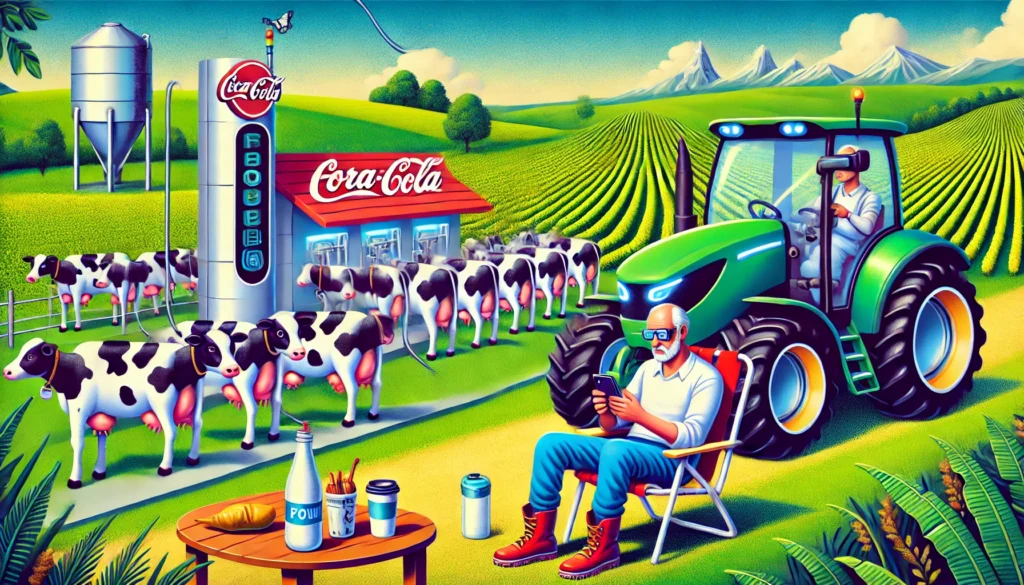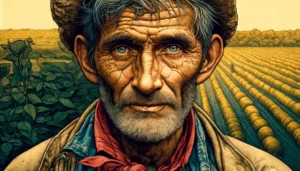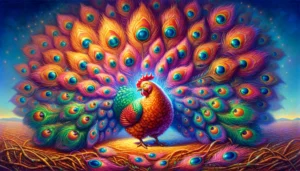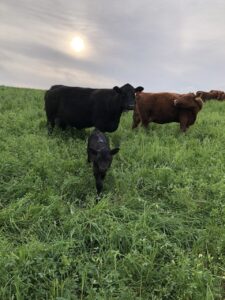
FarmerCowboy.com A satirical depiction of a futuristic farm where a self driving tractor operates in a lush green field with a farmer sitting on a Alan Nafzger 2.webp.webp
Modern Farming Face an Existential Crisis
Farming has always been about resilience and purpose. But in an age where self-driving tractors do the plowing, TikTok dictates trends, and influencers stage photo ops on hay bales, the soul of farming seems to be slipping away. With each passing season, traditional farmers find themselves caught in a paradox: their fields are thriving, but their sense of meaning is withering. Are we growing crops, or just growing hashtags?
The heart of the crisis lies in the clash between tradition and technology, with farmers asking hard questions about their role in this brave new world. From barns turned into digital hubs to cows experiencing existential crises thanks to automated milking machines, farming is no longer just about putting food on the table—it’s a comedy of errors, frustration, and, occasionally, a bit of viral fame.
Tractors That Drive Themselves, Farmers That Don’t Know Where to Go
The rise of self-driving tractors has revolutionized farming, but at what cost? Watching his tractor expertly navigate rows of corn without him, George Tillman of Iowa confessed, “I spent the entire afternoon staring at it like I was supervising my own replacement.”
Agricultural economist Dr. Clara Hayes sees a trend that’s as troubling as it is efficient. “Automation reduces labor demands but creates a disconnect between farmers and their fields. It’s hard to feel pride in work you didn’t actually do.” A survey by Farming Weekly revealed that 62% of farmers felt “less connected” to their work due to automation, and a growing number admit to spending more time on their phones than watching their crops grow. It’s as if farming has become a spectator sport, with tractors as the athletes.
From Fields to Feeds: The Rise of FarmTok
If you thought farmers were too busy to scroll TikTok, think again. Platforms like TikTok have turned agriculture into “FarmTok,” where planting is optional, but filming is mandatory. Betsy Harper, a cattle rancher, rolled her eyes while recounting a neighbor’s antics. “I saw him spend an hour choreographing a dance routine with his sheep. The sheep were bored, and so was I.”
Kyle Nash, a social media analyst, says the trend isn’t surprising. “Farming influencers aren’t selling produce; they’re selling personalities. The algorithm rewards entertainment, not substance.” In fact, Pew Research found that 48% of Gen Z farmers spend more time creating online content than managing their crops. One young farmer bragged, “My video of a cow wearing sunglasses got half a million likes. The problem is, I forgot to order feed for the herd.”
FarmTok may be fun, but the growing obsession with likes over livestock is leaving traditional farmers shaking their heads.
Wi-Fi in the Barn, but Don’t Forget the Hay
Barns were once a place for honest, sweaty labor, but now they’ve become rural co-working spaces, complete with broadband and video conferencing. Farmer Steve Dwyer laughed, recalling the time his prized cow disrupted a Zoom meeting. “I was pitching an idea to investors when she wandered into the frame. I just said, ‘Meet Bessie. She’s our new VP of Quality Control.’”
According to a USDA report, 35% of farmers now use their barns for remote work, and FCC data shows that rural broadband adoption has increased by 70% over the past decade. While connectivity has its perks, some farmers feel the soul of the barn is being lost. “It used to smell like hay and hard work,” lamented Dwyer. “Now it smells like burnt coffee and frustration.”
When the Weather App Lies, Everyone Pays
Farmers have embraced AI-powered weather apps, but when a forecast goes wrong, it’s chaos in the fields. Hank Stevens, a soybean farmer, threw his hands up after his app promised clear skies but delivered a downpour. “I was out there in my shorts, soaking wet, chasing tarps like a fool,” he said.
Dr. Alana Kim, a meteorologist, explains that while AI is great at analyzing patterns, it struggles with rapid climate shifts. Precision Ag reported that unexpected weather caused 27% of crop losses in 2023, and many farmers are starting to trust their gut over the gadgets. “It’s like flipping a coin and hoping for the best,” joked Stevens.
Automated Milkers and Cows in Existential Crises
Automation has reached the barn, with robotic milking systems taking over dairy farms. But as cows queue up like they’re at a drive-thru, farmers can’t help but laugh—and worry.
“I swear, they’re going to start ordering cappuccinos,” joked dairy farmer Martha Hill. While automated systems improve efficiency, Dr. James Rourke notes they also remove the human touch. A Dairy Farmers Association poll found that 60% of farmers miss the bond they once had with their herds. “These machines might milk the cows, but they’ll never understand them,” said Hill.
Farmers vs. Influencers: A Battle for the Fields
Rural America has a new rivalry: real farmers vs. influencers in cowboy hats. Dave Carter, a lifelong rancher, scoffs at the sight of influencers using tractors as props. “They spend 20 minutes posing and not a second working. It’s embarrassing.”
Karen Lau, a social media expert, says these influencers are reshaping the image of farming, for better or worse. “They bring attention to rural life but often misrepresent its realities.” A YouGov poll revealed that 43% of farmers feel misrepresented by influencers, who often trade authenticity for aesthetics. As Carter put it, “If you can’t tell me how to fix a broken fence, get off my land.”
Drone Deliveries and Kale on the Roof
Farm-to-table has gone high-tech, with drones delivering produce faster than ever. But faster isn’t always better, as Jenny Michaels discovered when her drone-dropped carrots landed on her roof. “I had to climb up there with a broom,” she grumbled.
Dr. Leah Gross sees potential in drone tech but warns of its downsides. “It’s efficient, but it risks alienating consumers from the human side of farming.” AgTech Digest reported a 45% increase in drone deliveries in 2024, but as Michaels put it, “If my food’s arriving by air, at least let me know how to land it.”
Helpful Tips for Farmers and Cowboys in the Digital Age
Step-by-Step: Balancing Tech and Tradition
- Let the self-driving tractor handle the grunt work, but stay engaged with the process.
- Use AI weather apps for guidance, but always trust your eyes—and maybe a good pair of boots.
Pro Tips for Spotting Real Farmers
- Look for calloused hands, not staged selfies.
- If their boots are cleaner than their hat, they’re probably an influencer.
Best Practices for Surviving FarmTok
- Post your cow selfie, but remember: the cows don’t feed themselves.
- When in doubt, ask yourself: Is this helping my farm or just my follower count?
Disclaimer:
This article is satire. If it feels too real, just remember: the line between absurdity and modern farming is getting thinner by the season.

Originally Published at FarmerCowboy.com
2024-12-31 10:11:21
Karl Hoffman is a distinguished agriculturalist with over four decades of experience in sustainable farming practices. He holds a Ph.D. in Agronomy from Cornell University and has made significant contributions as a professor at Iowa State University. Hoffman’s groundbreaking research on integrated pest management and soil health has revolutionized modern agriculture. As a respected farm journalist, his column “Field Notes with Karl Hoffman” and his blog “The Modern Farmer” provide insightful, practical advice to a global audience. Hoffman’s work with the USDA and the United Nations FAO has enhanced food security worldwide. His awards include the USDA’s Distinguished Service Award and the World Food Prize, reflecting his profound impact on agriculture and sustainability.




Why did the farmer name his horse ‘Five Miles’? Because he can’t run five miles!